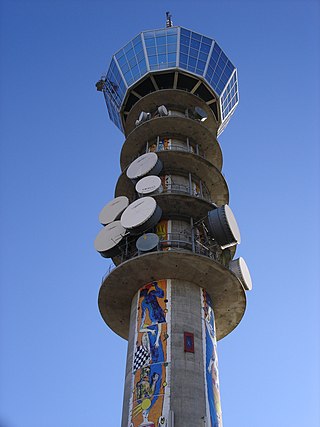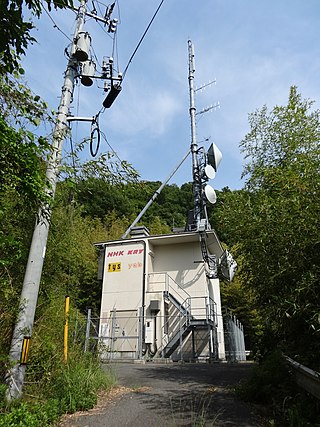A television network or television broadcaster is a telecommunications network for distribution of television program content, where a central operation provides programming to many television stations or pay television providers. Until the mid-1980s, television programming in most countries of the world was dominated by a small number of terrestrial networks. Many early television networks evolved from earlier radio networks.

Radio broadcasting is the transmission of audio (sound), sometimes with related metadata, by radio waves to radio receivers belonging to a public audience. In terrestrial radio broadcasting the radio waves are broadcast by a land-based radio station, while in satellite radio the radio waves are broadcast by a satellite in Earth orbit. To receive the content the listener must have a broadcast radio receiver (radio). Stations are often affiliated with a radio network that provides content in a common radio format, either in broadcast syndication or simulcast, or both. Radio stations broadcast with several different types of modulation: AM radio stations transmit in AM, FM radio stations transmit in FM, which are older analog audio standards, while newer digital radio stations transmit in several digital audio standards: DAB, HD radio, DRM. Television broadcasting is a separate service that also uses radio frequencies to broadcast television (video) signals.
Public broadcasting involves radio, television and other electronic media outlets whose primary mission is public service. Public broadcasters receive funding from diverse sources including license fees, individual contributions, public financing and commercial financing.

Terrestrial television or over-the-air television (OTA) is a type of television broadcasting in which the signal transmission occurs via radio waves from the terrestrial (Earth-based) transmitter of a TV station to a TV receiver having an antenna. The term terrestrial is more common in Europe and Latin America, while in Canada and the United States it is called over-the-air or simply broadcast. This type of TV broadcast is distinguished from newer technologies, such as satellite television, in which the signal is transmitted to the receiver from an overhead satellite; cable television, in which the signal is carried to the receiver through a cable; and Internet Protocol television, in which the signal is received over an Internet stream or on a network utilizing the Internet Protocol. Terrestrial television stations broadcast on television channels with frequencies between about 52 and 600 MHz in the VHF and UHF bands. Since radio waves in these bands travel by line of sight, reception is generally limited by the visual horizon to distances of 64–97 kilometres (40–60 mi), although under better conditions and with tropospheric ducting, signals can sometimes be received hundreds of kilometers distant.
Television broadcasting in Greece began in 1966, preceded in 1951 by statute 1963 permitting television broadcasting.

It is generally recognized that the first radio transmission was made from a temporary station set up by Guglielmo Marconi in 1895 on the Isle of Wight. This followed on from pioneering work in the field by a number of people including Alessandro Volta, André-Marie Ampère, Georg Ohm and James Clerk Maxwell.

The BBC Home Service was a national and regional radio station that broadcast from 1939 until 1967, when it was replaced by BBC Radio 4.

ARD is a joint organisation of Germany's regional public-service broadcasters. It was founded in 1950 in West Germany to represent the common interests of the new, decentralised, post-war broadcasting services – in particular the introduction of a joint television network.

RIAS was a radio and television station in the American Sector of Berlin during the Cold War. It was founded by the US occupational authorities after World War II in 1946 to provide the German population in and around Berlin with news and political reporting.
The Berliner Rundfunk (BERU) was a radio station set in East Germany. It had a political focus and discussed events in East Berlin. Today it is a commercial radio station broadcast with the name "Berliner Rundfunk 91.4".
Television in Germany began in Berlin on 22 March 1935, broadcasting for 90 minutes three times a week. It was home to the first public television station in the world, named Fernsehsender Paul Nipkow.
WOC is a commercial AM radio station, licensed to Davenport, Iowa, and serving the Quad Cities of Iowa and Illinois. WOC is owned by iHeartMedia, Inc. It broadcasts a news/talk format, under the slogan "The Quad Cities News Leader." Its studios are located at 3535 East Kimberly Road in Davenport. Its transmitter is located at an antenna farm in Bettendorf, Iowa, near the campus of Scott Community College. WOC broadcasts with 5,000 watts with a directional signal to avoid interfering with other stations on 1420 kHz.

Rundfunk Berlin-Brandenburg is an institution under public law for the German states of Berlin and Brandenburg, based in Berlin and Potsdam. RBB was established on 1 May 2003 through the merger of Sender Freies Berlin (SFB) and Ostdeutscher Rundfunk Brandenburg (ORB), based in Potsdam, and is a member of the Association of PSBs in the Federal Republic of Germany (ARD).

Saarländischer Rundfunk is a public radio and television broadcaster serving the German state of Saarland. With headquarters in the Halberg Broadcasting House in Saarbrücken, SR is a member of the ARD consortium of German public-broadcasting organizations.

TVNZ 1 is the first national television channel owned and operated by the state-owned broadcaster Television New Zealand (TVNZ). It is the oldest television broadcaster in New Zealand, starting out from 1960 as independent channels in the four main centres of Auckland, Wellington, Christchurch and Dunedin, networking in 1969 to become NZBC TV. The network was renamed Television One in 1975 upon the break-up of the New Zealand Broadcasting Corporation, and became a part of TVNZ in 1980 when Television One and South Pacific Television merged. The channel assumed its current name in October 2016.

Rundfunk der DDR was the collective designation for radio broadcasting organized by the State Broadcasting Committee in the German Democratic Republic (GDR) until German reunification in 1990.

The Voice of Vietnam or VOV is the Vietnamese national radio broadcaster. Directly controlled by the government of Vietnam, it is tasked with propagating the policies of the Party and the laws of the state.

Satellite television is a service that delivers television programming to viewers by relaying it from a communications satellite orbiting the Earth directly to the viewer's location. The signals are received via an outdoor parabolic antenna commonly referred to as a satellite dish and a low-noise block downconverter.

A broadcast relay station, also known as a satellite station, relay transmitter, broadcast translator (U.S.), re-broadcaster (Canada), repeater or complementary station (Mexico), is a broadcast transmitter which repeats the signal of a radio or television station to an area not covered by the originating station. It expands the broadcast range of a television or radio station beyond the primary signal's original coverage or improves service in the original coverage area. The stations may be used to create a single-frequency network. They may also be used by an AM or FM radio station to establish a presence on the other band.
Radio Forces Françaises de Berlin was a broadcaster catering to the French military contingent in the French Sector of West Berlin. It was located in the Quartier Napoléon near Tegel Airport in the French sector.













